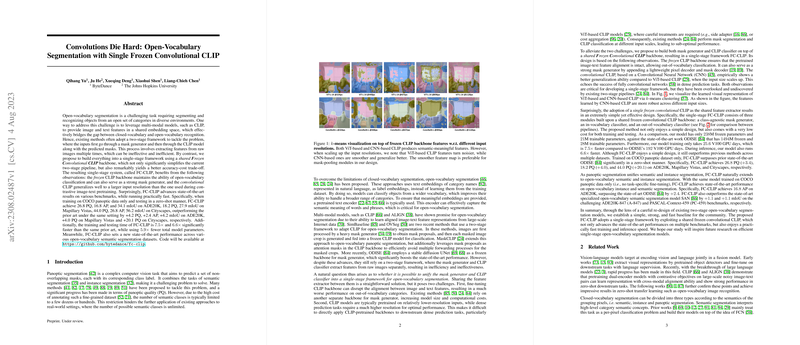Insightful Overview of "Convolutions Die Hard: Open-Vocabulary Segmentation with Single Frozen Convolutional CLIP"
This paper introduces FC-CLIP, a novel single-stage framework for open-vocabulary segmentation, leveraging a frozen Convolutional CLIP backbone. The authors aim to address the inefficiencies present in existing two-stage approaches by integrating both mask generation and classification within a unified architecture. This approach not only maintains the alignment capability for open-vocabulary classification characteristic of CLIP models but also enhances performance and computational efficiency across diverse benchmarks.
The core contribution of this work is the consolidation of previous pipelines into a single-stage model using a shared frozen convolutional backbone. By employing a Convolutional Neural Network (CNN) architecture—specifically, ConvNeXt-Large CLIP—the model benefits from the generalization abilities of convolutional networks for variable input resolutions, a limitation noted in ViT-based CLIP implementations. FC-CLIP inherently supports efficient training and inference by eliminating redundant feature extraction processes seen in segregated frameworks.
Numerical results substantiate the robustness of the approach, with FC-CLIP outperforming existing methods across multiple open-vocabulary panoptic and semantic segmentation datasets, including COCO, ADE20K, Mapillary Vistas, and Cityscapes. Particularly notable improvements occur on ADE20K, where FC-CLIP achieves 26.8 PQ, representing an advancement of +4.2 over previous state-of-the-art models. Furthermore, training and testing efficiencies are improved significantly, demonstrating 7.5× faster training and 6.6× faster inference, while using 5.9× fewer parameters than ODISE.
The paper provides insights into the operational dynamics of shared frozen backbones for segmentation tasks, emphasizing the alignment advantages retained by freezing the CLIP. This effectively counters the degradation seen when fine-tuning on additional datasets or tasks. The ensemble of in-vocabulary and out-of-vocabulary classifiers, which combines learned task-specific alignments with zero-shot capabilities inherent in CLIP, further underlines the flexibility and robustness of the model.
The paper's practical implications enhance real-time applications in domains requiring dynamic segmentation capabilities across an expansive set of categories, such as autonomous vehicles or augmented reality systems, which necessitate highly efficient and adaptable models. The theoretical advancement offers a pathway for future exploration into single-stage frameworks, pushing towards maximally efficient designs that do not compromise on extensive vocabulary coverage.
By exploring the trade-offs between various model architectures and segmentation frameworks (e.g., Mask2Former, kMaX-DeepLab), the research also elucidates the broader applicability of adopting convolution-based CLIP models for segmentation tasks. Indeed, the findings may encourage future studies to explore enhanced fusion techniques or investigate additional backbone architectures suitable for segmentation within versatile contexts.
Overall, the paper represents an efficient realignment of existing segmentation paradigms, showcasing how targeted architectural choices can lead to substantial computational and performance benefits. These insights, coupled with strong empirical results, suggest that FC-CLIP may serve as a conduit for ongoing innovation in open-vocabulary segmentation systems, harmonizing the need for comprehensive recognition capabilities with agility and operational feasibility.
